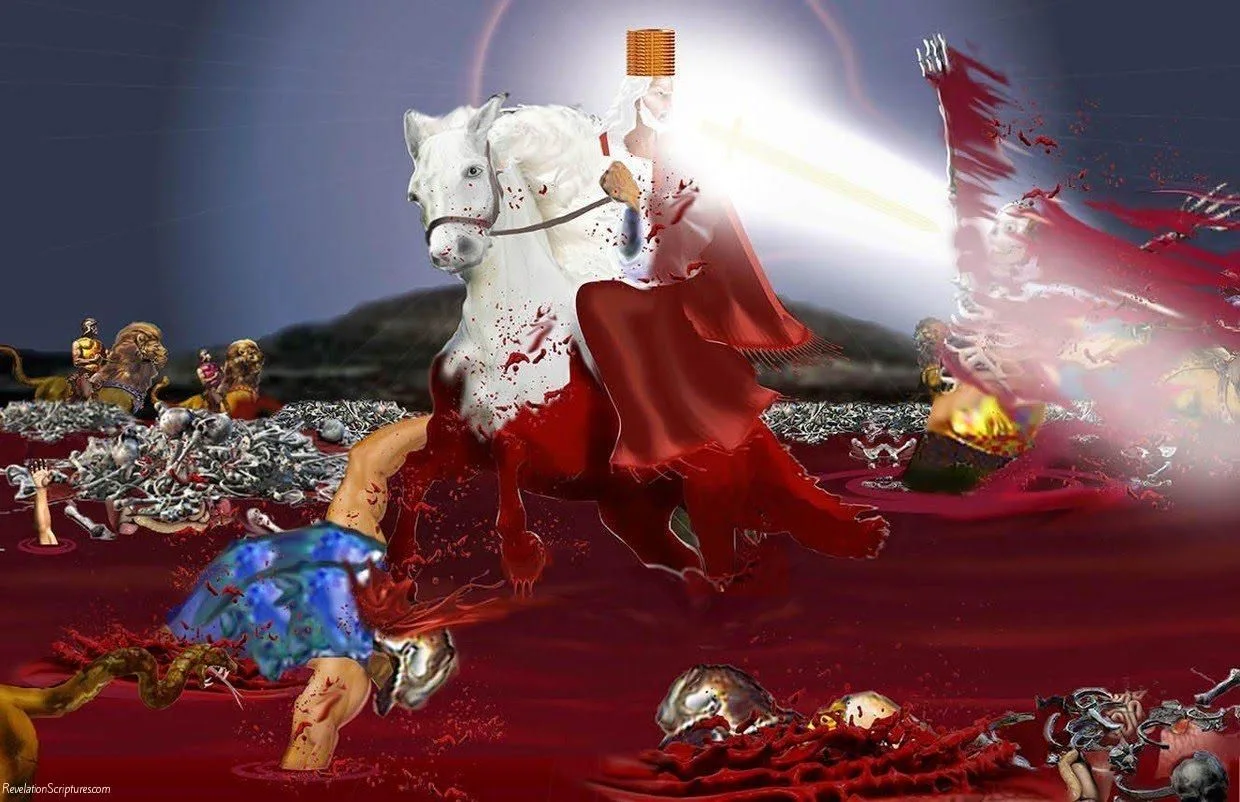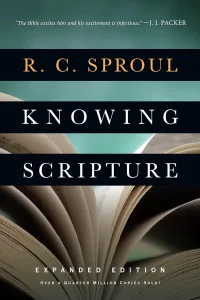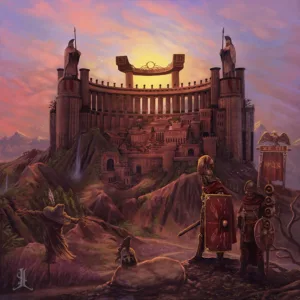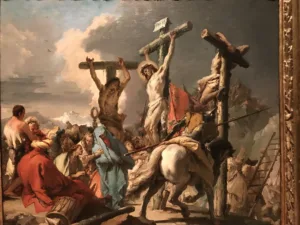I recently heard a message from the Bible that I found alarming. As well as being alarming, I found it disingenuous because it came from the pastor of a church. In Eph 4:11-12 we find the passage:
And he gave the apostles, the prophets, the evangelists, the shepherds and teachers, to equip the saints for the work of ministry, for building up the body of Christ, (Eph 4:11-12)
In the West, interpreting this passage seems to have become “telling the saints WHAT to think.” Pastors are not taking the time to “train the saints HOW to think.”
As persecution in the West gets more strident, that model may change. I hope so. But sounding that alarm is a different post.
The message that sparked this post covered some of what to expect because we are in the End Times. The preacher referenced Rev 14:19-20 as an accounting of the reaping of souls by an angel. The premise was this. We can (and should) expect this reaping in the future. This reaping will result in a river or pool of blood flowing as deep as “the bridle on a horse for 200 miles”. The preacher declared it to be a gruesome literal account.
I call this type of thinking hyper-literalism. I am concerned about it. It seems especially prevalent among people predisposed to a premillennial take on eschatology. I am not arguing against the content of the message. I am arguing against the dogmatism of the message.
Eschatological discussions involve the interpretation of a particularly complex genre of text. The genre is apocalyptic literature, unique to some prophetic utterance passages. It is difficult to decipher. It requires digging into cultural context. It requires an understanding of the conditions and worldviews of the original audience. The text was originally written for them, after all. It requires looking at it as they would.
Approaching the text with 21st-century lenses in your glasses will set you up for failure. This is generally true about the entire Bible. This is particularly true with apocalyptic (prophetic) books. Apocalyptic literature is rife with symbolism. You must dig into the cultural context to hope for accurate exegesis. Even then, you must hold your conclusions with humility. The odds that you are 100% correct in interpreting Revelation are improbable. The same is true of all apocalyptic literature.
It doesn’t mean we shouldn’t try, though. God wants us to know him as well as we can.
All Scripture is breathed out by God and profitable for teaching, for reproof, for correction, and for training in righteousness, that the man of God may be complete, equipped for every good work. (2 Tim 3:16)
I want to appeal to all believers to do two things:
- Be curious about God. Work at it and come to conclusions.
- Abandon any tendency towards dogmatism in interpreting prophecy.
I will use three examples from the Book of Revelation.
Rev 14:20 ESV: And the winepress was trodden outside the city, and blood flowed from the winepress, as high as a horse’s bridle, for 1,600 stadia.
Rev 21:15-16 ESV: And the one who spoke with me had a measuring rod of gold to measure the city and its gates and walls. The city lies foursquare, its length the same as its width. And he measured the city with his rod, 12,000 stadia. Its length and width and height are equal.
Rev 19:21 ESV: And the rest were slain by the sword that came from the mouth of him who was sitting on the horse, and all the birds were gorged with their flesh.
My ESV study notes tell me a stadion (the singular of stadia) is 607 feet. That means the measure of distance in Rev 14:20 is ~ 184 miles. The preacher called it 200 miles, but what is 16 miles among friends? I will use my measure because if I use his number, it exaggerates my point. In Rev 21:15-16, the measure of distance comes to ~ 1380 miles.
So let’s break out Rev 14:20:
I am assuming that the horse is 15 hands high. That is a tall horse but not the tallest horse there is. It is, however, a horse befitting a King, riding in battle to conquer. Remember, the numbers get larger if I get taller on the horse.
I am making another assumption. Blood has characteristics like water. When pooling, it seeks its lowest level. It spreads in all directions until it hits an obstacle that contains it. Without a canyon to constrain it, it will form a pool of some size. The size we get from scripture is ~ 184 miles.
What would this look like if we take it at face value? I have broken down the elements of the scenario to describe the details. I have made some assumptions but tried to be conservative in building my case.
Break Down of Rev 14:20
| Element In Question | Calculated Value |
|---|---|
| Height above the ground of a horse’s withers. Roughly the height of the bridle. (horse’s height = 15 hands, a hand = 4”) Measured in feet. | 5 |
| The volume of blood in the average human body. Measured in gallons. | 0.75 |
| The diameter of the pool of blood formed. (number of stadia* 607 ft/5280) Measured in miles | 183.9394 |
| The radius of the pool of blood (Diameter/2). Measured in miles. | 91.9697 |
| Area of the surface of the pool of blood. Measured in sq miles. | 26572.99024 |
| Convert sq miles to sq ft (for ease of calculating volume) (sq miles * 27878400) | 7.408124511×10.11th or 740812451100000000000 sq ft |
| The volume of the pool of blood in cu ft (sq ft *5) | 3.704062256×10.12th or 3704062256000000000000 cu ft |
| Convert cu ft to gallons (cu ft * 7.48051948) | 2.770830986×10.13th or 27708309860000000000000 gal |
| The number of Humans bleeding out required to produce a pool of blood that size (gal/0.75) | 3.694441314×10.13th or 36944413140000000000000 people |
| The number of humans alive in the world today | 8.1×10.8th or 8,100,000,000 |
| The number of people required to create a pool of blood this large. Expressed as a percentage of people living today. | 4561.04% more than are alive today |
In other words, a literal interpretation of the description of the blood flow in Rev 14:20 requires the following:
- 4,561 times the number of people that are alive on the planet today
- and they will die and bleed out when the angel reaps.
What happens if one reduces my calculations by 80%?
The number remains 912.2 times greater than the number of people today.
A planet this size could not sustain that many people. It is improbable there would ever be that many people on Earth. Prophets of God do not deal with improbabilities. They deal in certainties, or they are false prophets.
We have to keep in mind that a percentage of the people on the planet are believers. They are not going to be in the reaper’s count. If we take the numbers from the Pew Research Center, there are 2.3 billion of that 8.1 billion people who are Christians. But that is not the point.
The point is there are massive problems with taking that description literally. I am not saying that God can’t do this. God can do anything it is philosophically possible to do. But clear to me that there is a much better explanation for the scenario in Rev 14:20.
Doesn’t it make much more sense that the language is symbolic? It is a graphical description of the event. The event is horrific, widespread, and, in fact, global. It is a catastrophic reaping of the enemies of God. It is not a literal pool of blood 184 (or 200) miles in diameter and 5 feet deep. The author is using hyperbolic language to describe the indescribable.
Now let’s break out Rev 21:15-16
This one is easier to analyze. I can do it with a couple of visual images. The scenario is New Jerusalem coming from heaven to the earth. Its description is of a city that, given the measure of a stadion, is a cube with a dimension of 1380 miles. Here are a couple of maps to assist us in visualizing what that would look like as a literal scenario.
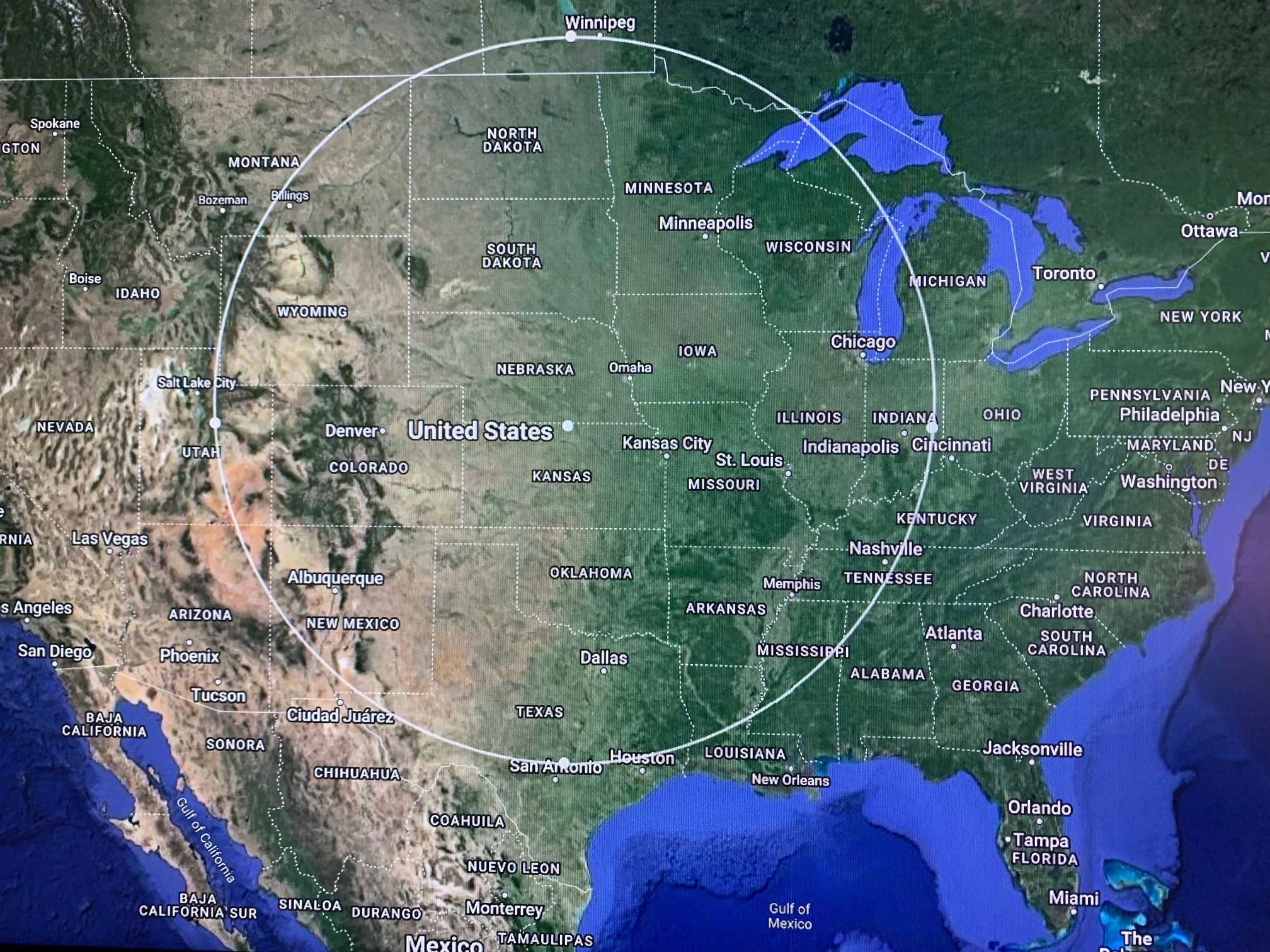
If New Jerusalem Were in the US
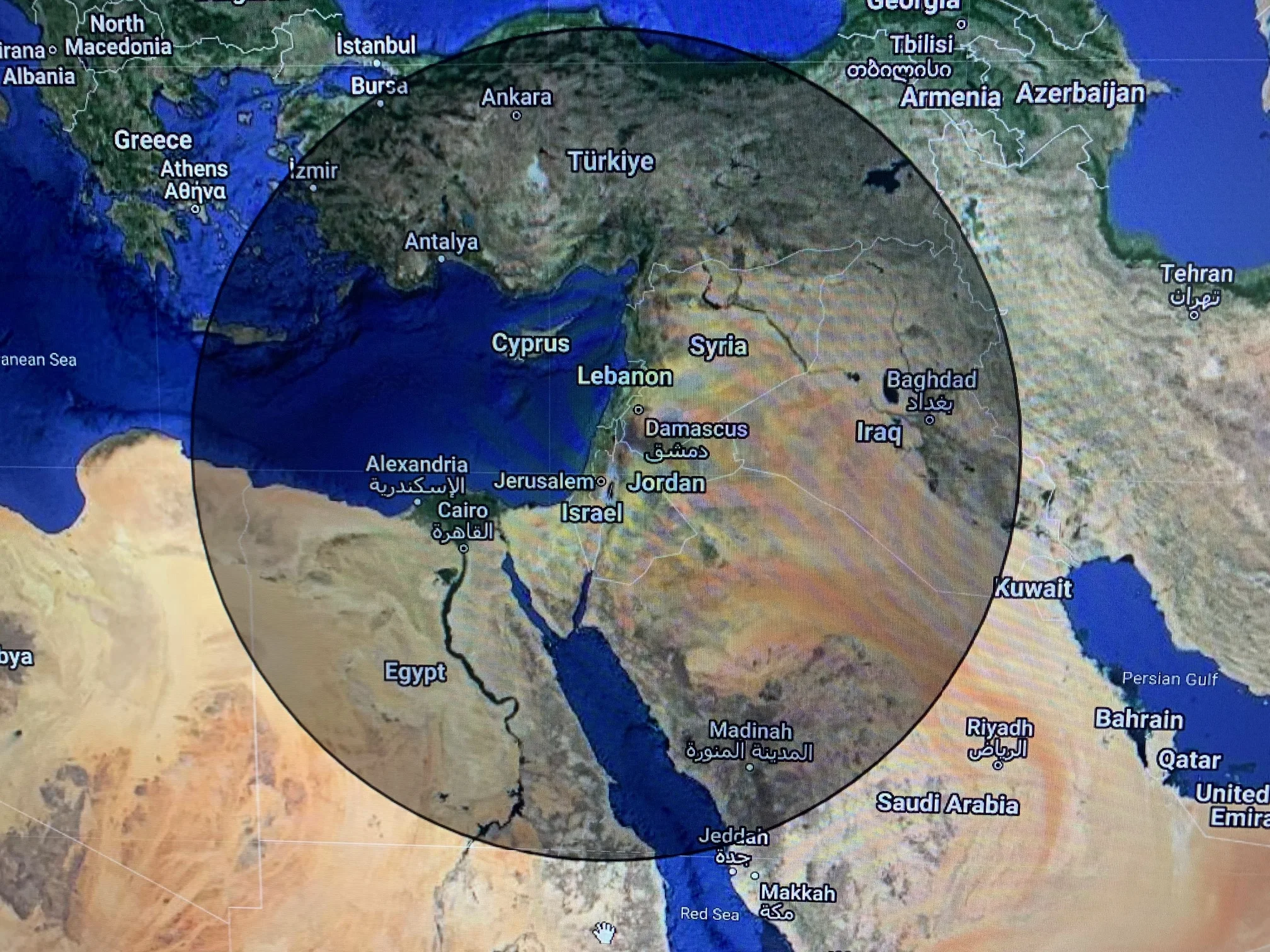
If New jerusalem Were In Israel
We have to imagine those circles as squares to get the full effect of Rev 21:15-16. Then, we must imagine the squares as cubes.
I can’t imagine that a thinking person would take the dimensions of this passage as literal. The problems with doing that are massive. That would be a city that no one could inhabit. Again, the skeptic is correct when he says God can do anything he wants. For instance, God could expand the size of the New Earth. Then, it would accommodate those dimensions. It would still be strange for a city to be that tall.
It makes much more sense to interpret this description as symbolic language. It describes a city of overwhelming majesty in both size and grandeur. It suits the King of the Cosmos as a capital. It’s better than insisting on a city that is a 1380-mile cube.
Finally, what about Rev 19:21
Do you want to insist on a sword that is a literal appendage projecting from the mouth of the Lord? Most people are more insightful than that. Think of the image – of Jesus Christ wielding a sword with his tongue, slaying his adversaries. I am only adding it to underscore my point.
My point is this. I have done a breakdown of three examples from the Bible. All references are from the Book of Revelation. They show John’s use of symbolic language in describing the events of the Apocalypse of Jesus Christ (Rev 1:1). These are only three of the scores of examples used throughout the Book. There are so many more, like:
- Rev 7 — 144,000 sealed from every tribe of Israel. It CANNOT be a literal number. There are already over 350,000 converted Jews worldwide. This is according to jewsforjudaism.org. 144,000 must be symbolic. The number is already exceeded. It isn’t a mistake. It is a way to express the idea of the widespread conversion of Jews from all the tribes of Israel.
- Rev 11 – how about those fire-breathing two witnesses??
I could go on but I’m not going to. I have taken a long enough way around to get to my question.
This is my question. These examples reveal the symbolic use of language in apocalyptic literature. Even premillennialists rarely take the sword in the mouth to be literal. Why insist on a hyper-literalistic interpretation of the 1000 years of the millennium? Why manufacture the 7-year pretribulation rapture?
Is it because their entire eschatological system falls apart without those two premises? It isn’t an example of sound hermeneutical principles. Darby, Scofield, and Ryrie did their sales job well. But, what they sold seems to be snake oil.
I don’t want to tear down anyone’s belief system, but I am calling believers to consider the end of their thinking. Don’t slap ideas together because you like how they sound or make you feel good. Consider whether views result in a coherent worldview. I guarantee God is not an incoherent thinker.
None of us is omniscient. We often make educated guesses about the interpretation of apocalyptic passages. They can be challenging to understand. I don’t have a problem with that. I’m sure God has done this with the intent to keep us sharp by not being obvious about everything. He has kept some things back from our understanding. This keeps us humbled and prepared. We look for the return of Christ rather than getting lazy and smug in our knowledge. Had he wanted to, He could have told us exactly what was going on. Remember, He is much better at communicating than we are at listening.
I close with a clip from gotquestions.org. I don’t agree with everything they say. But this is a pretty good assessment of how to approach apocalyptic literature.
… Apocalyptic literature is a specific form of prophecy, largely involving symbols and imagery and predicting disaster and destruction. We find this type of language in Daniel (the beasts of chapter 7), Ezekiel (the scroll of chapter 3), Zechariah (the golden lampstand of chapter 4), and Revelation (the four horsemen of chapter 6) [for example]. The Prophetic and Apocalyptic books are the ones most often subjected to faulty eisegesis and personal interpretation based on emotion or preconceived bias. However, Amos 3:7 tells us, “Surely the Sovereign LORD does nothing without revealing his plan to his servants the prophets.” Therefore, we know that the truth has been told, and it can be known via careful exegesis, a familiarity with the rest of the Bible, and prayerful consideration. Some things will not be made clear to us except in the fullness of time, so it is best not to assume to know everything when it comes to prophetic literature. (https://www.gotquestions.org/Bible-genres.html (– emphasis mine)
Consider these ideas. They may save you from believing and saying nonsensical things. You will speak to people who might be otherwise reached with the gospel. Coherent ideas will be a great step toward establishing credibility for your ideas. Remember, ideas have consequences. Try to keep them fruitful consequences.
That’s what I have to say on the matter. I could be wrong.
The Bible is the written Word of God, and it is treasured by many. But it is also an ancient book about people and cultures very different than us. Thus, while we know we should read it, many of us have a hard time understanding the Bible. In this expanded edition of Knowing Scripture, R. C. Sproul helps us dig out the meaning of Scripture for ourselves. The author says, “The theme of this book is not how to read the Bible but how to study the Bible.” He presents in simple, basic terms a commonsense approach to studying Scripture and gives eleven practical guidelines for biblical interpretation and applying what we learn. With a minimum of technical jargon, Sproul tackles some of the knotty questions regarding differences of interpreting the Bible, including
- discovering the meanings of biblical words
- understanding Hebrew poetry, proverbs and parables
- approaching historical and didactic passages
- being careful with predictive prophecy
- discerning how culture conditions the Bible
- choosing and using Bible translations, commentaries, Bible software and other helps
Now, with a new preface, Knowing Scripture is a basic book for both beginning Bible readers and experienced students of Scripture.

Logos Bible Software
The Logos Bible Study app is a powerful Bible study and sermon prep platform. It allows you to study Scripture, commentaries, devotionals, Bible dictionaries, and more from your computer, tablet, or phone. If you want to know the Creator of the Universe intimately, you want this app.

Elevated Faith
Are you looking for apparel or swag? We picked Elevated Faith because of the diversity of their offerings. They offer some great ideas for gifts for others and treats for yourself.

